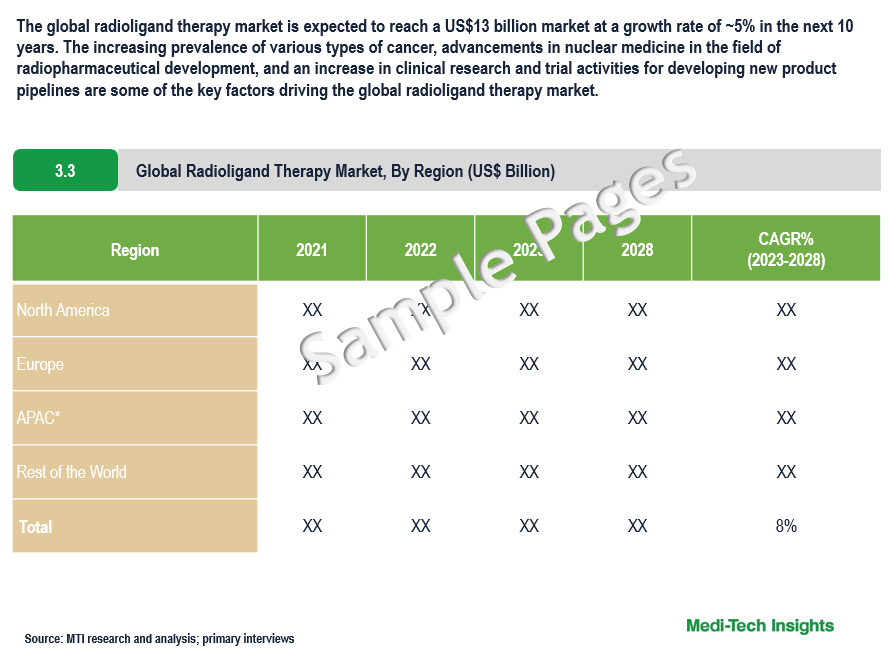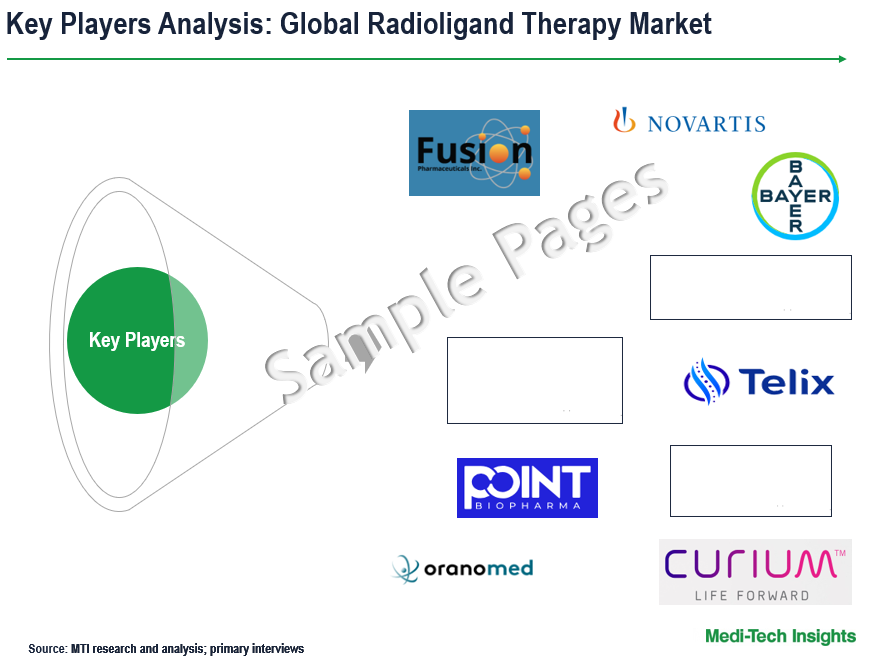
Radioligand Therapy (RLT) Market Size, Industry Growth, Trends, Analysis and Forecast to 2030
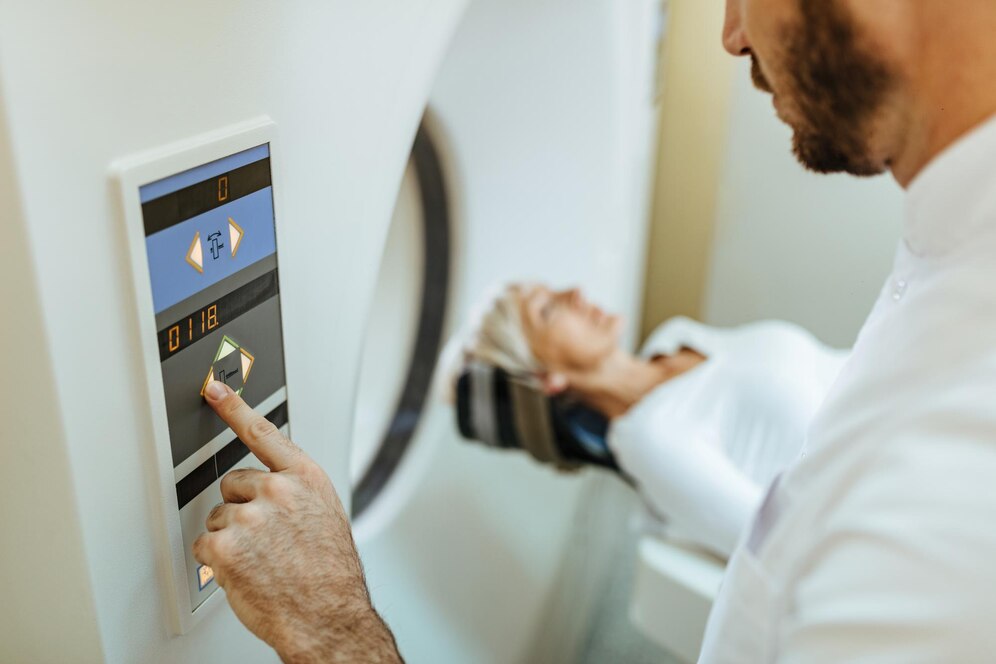
The Radioligand Therapy Market is expected to reach a US$13 billion market at a growth rate of ~5% by 2030. Increasing prevalence of various types of cancer, including prostate cancer and neuroendocrine tumors, advancements in nuclear medicine in the field of radiopharmaceutical development, a rising geriatric population, increasing awareness and understanding of radiotherapy isotopes, and an increase in clinical research and trial activities for developing new product pipelines are some of the key factors driving the radioligand therapy market. To learn more about the research report, fill out a quick inquiry for a sample report.
Radioligand therapy is a form of precision nuclear medicine for patients with advanced cancers. Radioligand therapy, also called radionuclide or radiopharmaceutical therapy, is a targeted cancer treatment that delivers radiation directly to cancer cells. Radioligand therapy can enable the precise targeting of cancer by linking a radioisotope to a targeting molecule that delivers radiation directly to cancer cells, enabling significant anti-tumor efficacy while limiting the impact on healthy tissue.
Radioligand therapies have 2 primary components: A radioisotope, which emits radiation that damages cells, and a targeted ligand, a molecule that binds to specific markers on cancer cells. The radioactive component has a very short half-life or the time it takes for the radioactivity to decrease by 50%. Once the radioactivity decays, it can no longer kill the cancer cells as effectively, which means radioligand therapy has a limited window of viability. By the time it is packaged and ready to ship, the treatment has to reach patients in a matter of days. Due to the limited time window for administration, these drugs are often produced in single-patient doses.
Advancement in Clinical Trials for Therapeutic Radiopharmaceutical Pipelines Will Drive Market Growth
Oncology research has made tremendous progress in recent years. Radioligand therapies have the potential to shift the standard of care in oncology. Clinical trials provide critical data on the efficacy and safety of therapeutic radiopharmaceuticals. The potential outcome helps researchers to treat various cancer types and diseases and attract investment from pharmaceutical companies. Therefore, advancements in clinical trials for therapeutic radiopharmaceutical pipelines have the potential to significantly drive market growth in the field. For instance,
- In December 2023, Lantheus Holdings, Inc. and POINT Biopharma Global Inc. announced statistically significant topline results from the pivotal phase 3 SPLASH study evaluating the efficacy and safety of 177Lu-PNT2002, a prostate-specific membrane antigen (PSMA)-targeted radioligand therapy (RLT), in patients with metastatic castration-resistant prostate cancer (mCRPC) after progression on an androgen receptor pathway inhibitor (ARPI).
- In May 2023, RadioMedix and Orano Med announced that the last patient had been dosed in the Phase II trial of the targeted alpha emitter therapy, 212Pb-DOTAMTATE (AlphaMedix). This trial is being conducted to evaluate the safety and effectiveness of AlphaMedix in peptide receptor radionuclide therapy (PRRT) of naive patients with somatostatin receptor-expressing neuroendocrine tumors (NET), regardless of the location of the primary tumor.
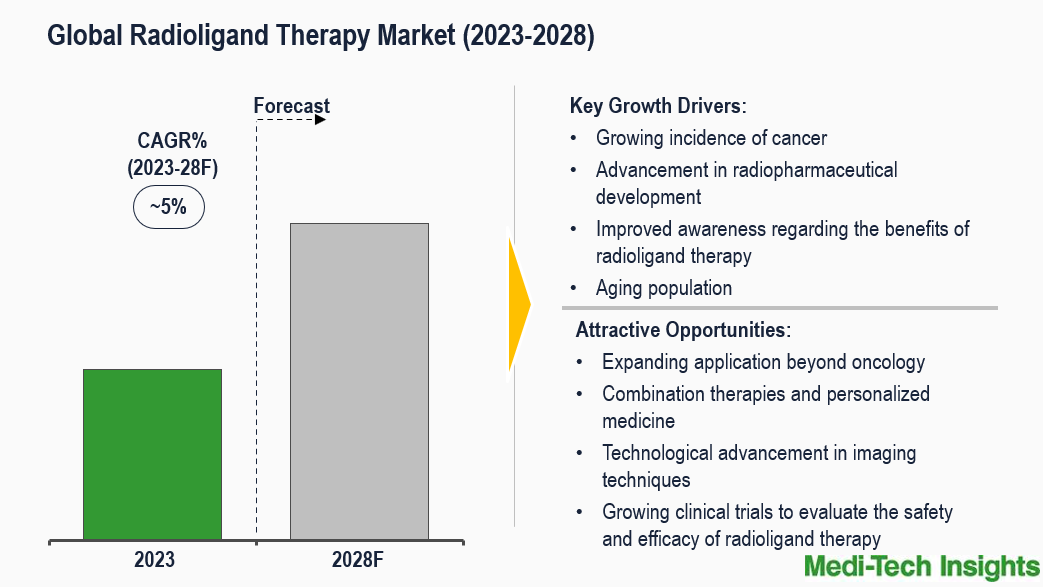
Fill out the "Quick Inquiry Form" to request a sample copy.
Emerging Applications of Radioligand Therapy in Neuroendocrine Neoplasms, Prostate Cancer, and Non-cancerous Conditions Fuel its Demand in the Market
Cancer care has seen progress in many areas, there has been development within the field of treatment and therapy yet for many people effective treatment options are still not available. The newest applications of radioligands focus on NETs and bone metastases in mCRPC, with research ongoing in many other cancer and non-cancer conditions as well. Radioligand therapy delivers radiation directly to select types of cells, and it is gradually emerging as an essential pillar in cancer care. Some of the emerging applications of radioligand therapy include:
- Neuroendocrine Neoplasms (NETs): Neuroendocrine cancers, also known as neuroendocrine neoplasms (NENs), include both neuroendocrine tumors (NETs) and neuroendocrine carcinomas (NECs). Radioligand therapy has demonstrated efficacy in the treatment of neuroendocrine tumors (NETs), which arise from neuroendocrine cells and can occur in various organs. Radioligand therapy improves progression-free survival and overall disease control and reduces tumor size. For instance,
-
- In September 2023, Novartis announced the Phase III NETTER-2 trial with Lutather (INN: lutetium (177Lu) oxodotreotide / USAN: lutetium Lu 177 dotatate) met its primary endpoint. First-line treatment with Lutathera in combination with long-acting octreotide demonstrated a significant improvement in progression-free survival (PFS) in patients with newly diagnosed somatostatin receptor (SSTR)-positive, Grade 2 and 3, advanced gastroenteropancreatic neuroendocrine tumors (GEP-NETs) versus high-dose long-acting octreotide alone.
- Prostate Cancer: Prostate cancer is the most commonly diagnosed cancer among men and the leading cause of cancer-related deaths worldwide. PSMA radioligand therapy utilizing urea-based agents with a- and β-particle emitting radionuclides example Lutetium-177, Actinium-225, Thorium-227, Terbium-161, Lead 212, etc. has been identified as a promising approach for hormone-sensitive as well as castrate-resistant prostate cancer patients. For instance,
-
- In October 2023, Novartis presented data from the Phase III PSMAfore trial at the 2023 European Society for Medical Oncology (ESMO) Congress. Data presented at the Presidential Symposium showed that Pluvicto™ (lutetium (177Lu) vipivotide tetraxetan) met its primary endpoint with a clinically meaningful and statistically significant benefit in radiographic progression-free survival (rPFS) in patients with prostate-specific membrane antigen (PSMA)-positive metastatic castration-resistant prostate cancer (mCRPC) after treatment with androgen receptor pathway inhibitor (ARPI) therapy, compared to a change in ARPI1.
- Non-cancerous Conditions: The primary focus of radioligand therapy is on cancer treatment, researchers are also exploring how the approach could be utilized in other non-cancerous conditions. For example:
-
- Inflammatory Conditions: Radioligand therapy has been investigated for its anti-inflammatory properties, and there is interest in its potential application in diseases with an inflammatory component.
-
- Arthritis: Some preclinical studies have explored the use of Radioligand in inflammatory joint conditions, such as rheumatoid arthritis. Research in this area is in the early stages.
The approach is also currently being explored both as a standalone treatment approach and in combination with other treatment modalities.
Radioligand Market - Key Constraints/Challenges
The radioligand therapy market faces several challenges and restraints. The initial and ongoing costs associated with the treatment can be significant. There are very few healthcare professionals trained in radioligand therapy which restricts the use of the approach to a small number of specialist centers. The regulatory frameworks for radioligands must also evolve to suit this emerging treatment modality. This may affect who provides treatment, and how. Radioligand therapy is a targeted form of cancer treatment and is only viable for a few days after it’s manufactured therefore other policy advances are needed in terms of the supply of radioisotopes and nuclear waste. Finally, the limited availability of representative clinical and economic data on radioligand therapy poses challenges.
North America Accounts for the Largest Share of the Global Market
North America has emerged as the predominant global market for radioligand therapy. The region experiences substantial market growth, driven by stringent regulations governing the healthcare and pharmaceutical sectors. Increasing investments from public and private funding and clinical progression for many radioligand therapy products, growing awareness among patients about the benefits of radioligand therapy, and a rise in the patient base suffering from cancer in the U.S. contribute significantly to the market growth. The European region is expected to witness lucrative growth during the forecast period. The growing initiative by the government to reduce the cancer burden, growing healthcare infrastructure, increased awareness about the availability of various therapies, and an increase in cancer prevalence present significant growth opportunities for the radioligand therapy market in the region.
Radioligand Market - Competitive Landscape
The top market players in the radioligand therapy market include Novartis International AG, POINT Biopharma Global Inc., Fusion Pharma, Orano Med, Clovis Oncology, Telix Pharmaceuticals, Lantheus Holdings, Inc., Bayer AG, Eli Lilly, Molecular Partners, ITM Isotope Technologies Munich SE, Curium Pharma, Precirix, and Radio Medix, among others.
Organic and Inorganic Growth Strategies Adopted by Players to Establish Their Foothold in the Market
Players operating in this market are adopting organic and inorganic growth strategies such as collaborations, and acquisitions to garner market share. For instance,
- In November 2023, Orano Med, a pioneer in targeted alpha therapy, and 48Hour Discovery, a novel peptide discovery platform company, announced their strategic collaboration to advance cancer treatment through radioligand discovery and development.
- In October 2023, Eli Lilly and POINT Biopharma Global, Inc. announced a definitive agreement for Lilly to acquire POINT, a radiopharmaceutical company with a pipeline of clinical and preclinical-stage radioligand therapies in development for the treatment of cancer.
- In September 2023, POINT Biopharma Global Inc. and Athebio AG announced a collaboration and license agreement to develop and commercialize DARPin-targeted radioligands (“Radio-DARPins”).
Radioligand therapy is an evolution of technology from imaging to therapy. The market is further expected to grow due to the growing investments from pharmaceutical companies for the development and commercialization of radioligand therapies, expansion of radioligand therapy applications, advancement in imaging technologies, and aggressive organic and inorganic growth strategies followed by the players.
Radioligand Therapy Market Scope
|
Report Metric |
Details |
|
Market Size |
US$13 billion by 2030 |
|
Expected Growth Rate |
~5% by 2030 |
|
Historical data |
2018 - 2022 |
|
Base year |
2023 |
|
Forecast period |
2023-2030 |
|
Components of Radioligand Therapy |
|
|
Emerging Applications of Radioligand Therapy |
|
|
Top Key Players |
Novartis International AG, POINT Biopharma Global Inc., Fusion Pharma, Orano Med, Clovis Oncology, Telix Pharmaceuticals, Lantheus Holdings, Inc., Bayer AG, Eli Lilly, Molecular Partners, ITM Isotope Technologies Munich SE, Curium Pharma, Precirix, and Radio Medix |
|
Market Growth Drivers |
|
Key Strategic Questions Addressed
- What is the market size & forecast for the Radioligand Therapy Market?
- What are the historical, present, and forecasted market shares and growth rates of various segments and sub-segments of the Radioligand Therapy Market?
- How has COVID-19 impacted the Radioligand Therapy Market?
- What are the major growth drivers, restraints/challenges impacting the market?
- What are the opportunities prevailing in the market?
- What is the investment landscape?
- Which region has the highest share in the global market? Which region is expected to witness the highest growth rate in the next 5 years?
- Who are the major players operating in the market? What is the competitive positioning of key players?
- Who are the new players entering the market?
- What are the key strategies adopted by players?
- Research Methodology
- Secondary Research
- Primary Research
- Market Estimation
- Market Forecasting
- Executive Summary
- Market Overview
-
- Market Dynamics
- Drivers
- Restraints
- Key Market Trends
- Industry Speaks
- Market Dynamics
- COVID-19 Impact on the Radioligand Therapy Market
- Global Radioligand Therapy Market - Size & Forecast (2021-2028), By Indication
- Prostate Cancer
- Neuroendocrine Tumours (NETs)
- Non-Cancerous Conditions
- Others
- Global Radioligand Therapy Market - Size & Forecast (2021-2028), By Products
- Approved Products
- Lutathera
- Zytiga
- Xtandi
- Xofigo
- Erleada
- Pluvicto
- Others
- Potential Pipeline
- Approved Products
- Global Radioligand Therapy Market - Size & Forecast (2021-2028), By End User
- Hospitals
- Clinics
- Pharmaceutical and Biotechnology companies
- Academic & Research Institute
- Others
- Global Radioligand Therapy Market - Size & Forecast (2021-2028), By Region
- North America (U.S. & Canada)
- Europe (UK, Germany, France, Italy, Spain, Rest of Europe)
- Asia Pacific (China, India, Japan, Rest of Asia Pacific)
- Rest of the World (Latin America, Middle East & Africa)
- Competitive Landscape
- Key Players and their Competitive Positioning
- Competitive Positioning of Key Players (2022)
- Offerings Assessment, By Player
- Key Strategies Assessment, By Player (2021-2023)
- New Product & Service Launches
- Partnerships, Agreements, & Collaborations
- Mergers & Acquisitions
- Geographic Expansion
- Key Players and their Competitive Positioning
- Key Companies Scanned (Indicative List)
- Johnson & Johnson Service Inc.
- Bayers Inc.
- Novartis International AG
- Amneal Pharmaceuticals LLC
- POINT Biopharma Global Inc.
- Pfizer Inc.
- Fusion Pharma
- Orano Med
- Clovis Oncology
- Telix Pharmaceuticals
- Lantheus Holdings, Inc.
- Molecular Partners
- ITM Isotope Technologies Munich SE
- Curium Pharma
- Precirix
- Radio Medix
- Other Prominent Players
The study has been compiled based on extensive primary and secondary research.
Secondary Research (Indicative List)
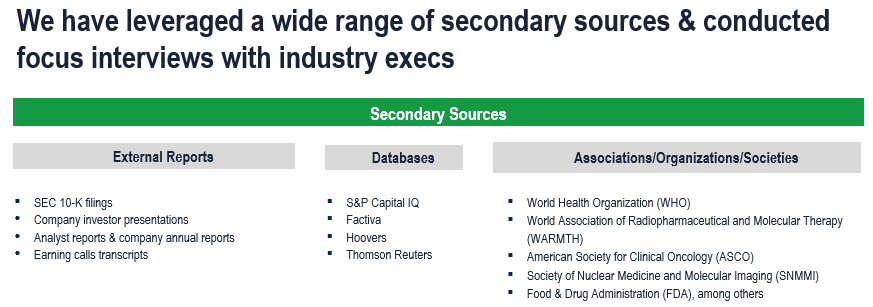
Primary Research
To validate research findings (market size & forecasts, market segmentation, market dynamics, competitive landscape, key industry trends, etc.), extensive primary interviews were conducted with both supply and demand-side stakeholders.
Supply Side Stakeholders:
- Senior Management Level: CEOs, Presidents, Vice-Presidents, Directors, Chief Technology Officers, Chief Commercial Officers
- Mid-Management Level: Product Managers, Sales Managers, Brand Managers, Business Development Managers, Consultants
Demand Side Stakeholders:
- Stakeholders in Hospitals, Clinics, Pharmaceutical and Biotechnology companies, Academic & Research Institute, and Other End Users
Breakdown of Primary Interviews
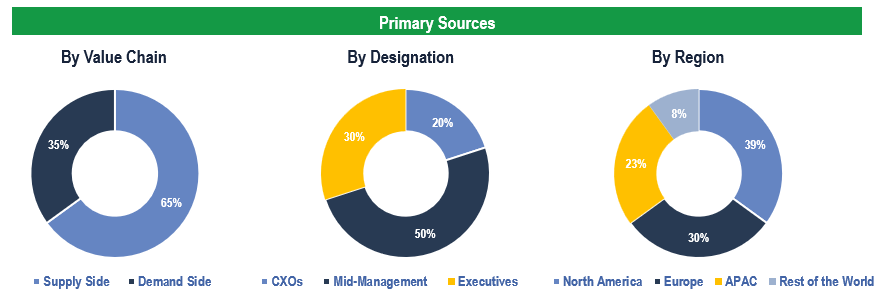
Market Size Estimation
Both ‘Top-Down and Bottom-Up Approaches’ were used to derive market size estimates and forecasts.
Data Triangulation
Research findings derived through secondary sources & internal analysis were validated with Primary Interviews, Internal Knowledge Repository, and Company Sales Data.
